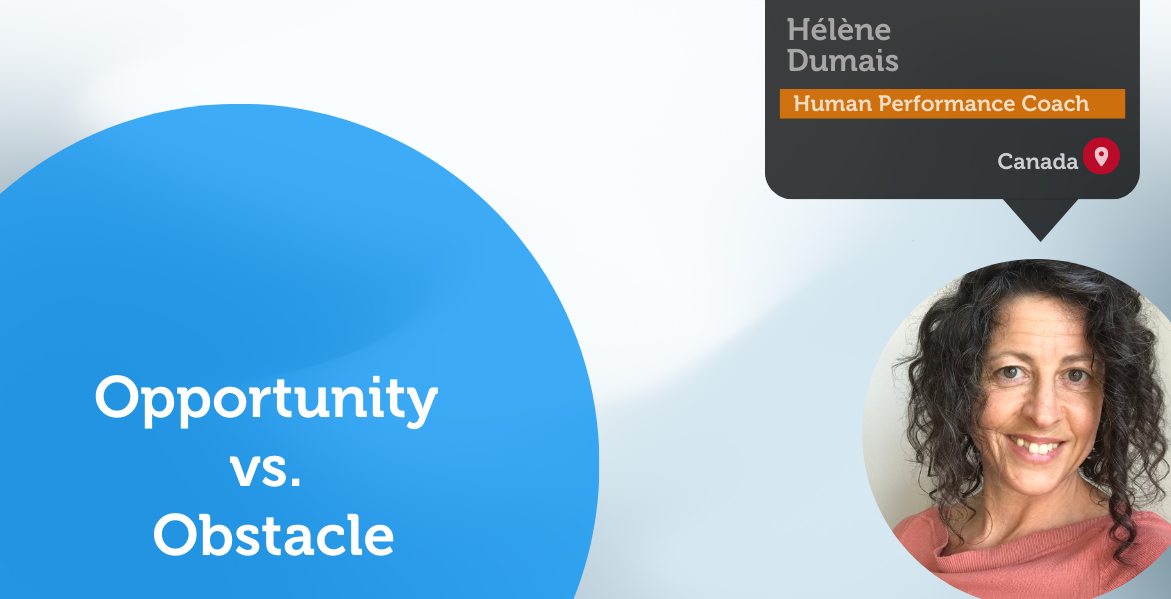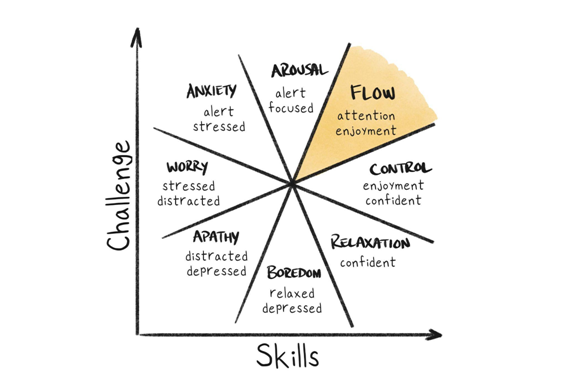A Coaching Power Tool By Hélène Dumais, Human Performance Coach, CANADA

Opportunity vs. Obstacle Power Tool
This coaching tool, an understanding of concepts with their practice and application, is designed for anyone curious, professionals and individuals, in getting more out of life.
Imagine we are on a hike in nature, and as we get to a suspension bridge that runs over a low-water creek, we see some boards of the deck are missing, which prevents us from walking across. This broken bridge can appear as an obstacle; thus, putting an end to our journey.
We must ask ourselves what it would have taken to decide, instead, to embark on a new journey of crossing the creek by foot. Alternatively, we could have contemplated traversing the bridge by hanging onto the wire rope frame and gliding across. Exploring further upstream to find the next bridge is yet another possible option. With a bit of ingenuity, we could have even gone as far as to fix the bridge, or perhaps call upon a handy friend to come lend a helping hand. As we wait for this individual, we could enjoy camping on-site; thus, transforming this broken bridge into an opportunity to explore and express a lot more.
We can choose to perceive our reality as a limited experience filled with big and small obstacles, or we can choose to see it as a myriad of opportunities. This raises the question: why do humans think that the existence or nonexistence of something or someone can stop them from achieving success and happiness in life? Flipping an obstacle into an opportunity can generate alternate possibilities that were otherwise not available, so why not do it in the first place? To learn this distinction, let’s start by understanding why obstacles appear first.
Understanding the Differences Between Opportunity vs. Obstacle
Decoding Obstacles
Real-life challenges may first appear as obstacles where there seems to be nothing we can do about it. Being fired, receiving a diagnosis of cancer, being in a precarious financial situation, losing a loved one, failing graduation, or getting an injury, to name a few examples. It is not rare these can even be interpreted as a curse.
The origin of viewing an obstacle in life from a negative perspective is largely rooted in the way we think. Our thought process is predominantly responsible for how we regard obstacles, as our brain is wired to prioritize risk avoidance; to perceive any situation with inherent biases and cognitive biases. This is a useful survival mechanism in a hostile natural environment but can be a hindrance in modern life. We often focus on the potential negatives of a situation, rather than the potential positives, leading to a negative outlook. This kind of fixed mindset, part of our brain’s “factory setting”, may also excuse us from any accountability for these obstacles.
Obstacles can be subtle and difficult to identify, as they are often situations or conditions we dislike, fear, or wish to avoid, yet they are still genuine. These can include feelings of disempowerment and a lack of choices like being born into poverty or a dysfunctional family. Other impediments may include labeling ourselves (consciously or not) based on our gender, socioeconomic, marital, ethnic, sexuality, or disability status. This can lead to a feeling of being a victim or of having bad luck and can limit us in who we are and what we can do.
Seizing the Opportunity
When we change our perspective about an obstacle; when we remove any label or belief around it, we can see the offering of an opportunity. It puts a spotlight on what we are truly capable of; what is fully possible. Flipping it to see the opportunity not only gives us access to express our full potential; it empowers us.
Obstacle = disempowerment
Living through interpretation of the situation with limited perspectives.
Opportunity = empowerment
Taking responsibility and owning the situation to see possibilities and create solutions.
The origin of viewing an obstacle in life from a positive perspective, as an opportunity, can be traced back to the ancient concept of stoicism, which was developed by the Greek philosopher Epictetus in the first century AD. Stoicism is a philosophy that teaches that we should focus on what we can control and accept what we cannot. It teaches us to view life’s difficulties as an opportunity for growth and improvement rather than a source of suffering. This is succinctly summarized in “the obstacle is the way”, a phrase attributed to Epictetus but popularized by author Ryan Holiday in his 2014 book of the same name.
An obstacle flipped into an opportunity gives access to new learnings, growth, higher resilience, and the expansion of our character strengths. It also leads to exploring more creative solutions, new perspectives, and avenues that were, otherwise, not available. In my Human-to-Hero™ coaching model, this process refers to seeing and taking the Call to Adventure. For it to occur, an increased self-awareness is required in order to bypass our brain’s default wiring mode we now know is not always beneficial to us.
Here is a 5-step roadmap to help us do that:
- To acknowledge that the human brain is wired to focus on the negative for risk avoidance.
- To clearly identify the obstacle, distinguishing the facts from our interpretation of them.
- To embrace the circumstances by uprooting any negative labeling and by being brutally honest to accept our role in creating them.
- To flip the obstacle to discover what opportunity it creates for us alone, as only we can recognize and take advantage of it.
- To constantly revisit the first step for giving ourselves compassion, building resilience, and creating the space for success.
Self-Coaching Practices
To best navigate this protocol and to apply the Opportunity vs. Obstacle distinction, there are a few notions that, when understood and practiced, can optimize our chances of success.
Cultivating a growth mindset is a major cornerstone in viewing and creating opportunities. Having a growth mindset means that we believe that our abilities can be developed through hard work and dedication, focusing on the progress made, and acknowledging the effort over the outcome. With this mindset, we can reframe our perspective of obstacles from seeing them as something that is stopping us from achieving our goals to a challenge that we can use as an opportunity to grow and become a better version of ourselves. Instead of feeling overwhelmed and powerless, we can focus on the lessons that we can learn from the obstacle, and use them to create a better outcome. We can use the obstacle as an opportunity to identify areas of improvement, develop new skills, and build resilience. Reframing our perspective in this way allows us to remain motivated and engaged, and to focus on achieving our goals instead of giving up.
Building mental toughness can help us, furthermore, in flipping our perspective faster; especially by developing the trait of Challenge, as described in the sport psychology 4 C’s model, which refers to the ability to reframe potential threats as opportunities for growth and mastery. Fitness celebrity and author Fred DeVito said “If it doesn’t challenge you, it won’t change you”. This ability allows taking risks and relies on learning in new situations.
Redefining the concept of choice can also present some fitness to support us. Decisions that take into account the pros and cons are often made within a restricted framework, with the options seen available acting as the only viable options for consideration. What if there is no alternative available to select from? This can leave us feeling constrained, with no freedom to choose. The reinvention of choice as a concept of “choosing to choose” eliminates the process of decision-making and the perception of having no choice. This can be a useful tool to enable immediate freedom, control, and empowerment.
Operating in a state of flow can assist us in overcoming obstacles and achieving success. By evaluating the difficulty of the challenge we are facing, relative to our ability to manage it, we can determine how much to break it into more manageable parts, so as to remain in a flow state and maintain the constant potential this obstacle presents for opportunity.

To complete this collection, exercising patience, positivity, and optimism, while recognizing the difference between facts from our interpretation of them, can help us alter our viewpoint. Providing time and attention, filled with love and compassion, to any obstacle that presents itself can ultimately transform it into a blessing, a chance, and a potential.
To Infinity and Beyond
When I competed in ultra distance running and obstacle course racing, I had to physically overcome obstacles such as climbing over walls, carrying heavy objects, or running 100+ miles distances while dealing with harsh weather, sleep deprivation, time restraint, and physical discomfort. The value and benefits of taking on a physical challenge can help us acquire tools quicker to first see the wall simply as a wall. In all those years of endurance competitions, I have developed and trained the ability to just be with the challenge; to “embrace the suck”, literally, and with a smile.
For that matter, I encourage everyone to undertake a physical challenge, always relative to one’s capacity most indubitably. When it is not an obstacle imposed by life, but one that we willingly undertake, we are much more prone to approach it with openness. It is subsequently easier to analyze and learn from the insights we get and identify the strengths and attributes we developed, in order to respectively apply and use these in other areas of our life.
Having completed an 888 kilometers trail race and becoming the first and only woman to do so, I no longer found excuses acceptable when facing an obstacle or challenge, whether it be work, personal, or sport related, instead transforming it into an opportunity. In the quest for mastery of this distinction, recalling our past successes in overcoming obstacles can provide self-confidence. As we hone our skills in recognizing obstacles as opportunities, we can become energized by the prospect of tackling the next challenge, secure in the knowledge that a reward awaits us on the other side. Next time someone asks “Are you looking for trouble?”, you may be tempted to answer “Actually yes, as I am starting to run out of challenges to overcome, and I am hungry for more opportunities.”
If you are interested in bringing this discussion to the next level, see my paper entitled
©Copyright protected and all rights reserved to Hélène Dumais and Hélène Performance.
References
Csikszentmihalyi, Mihaly. (1997). Finding Flow. Basic Books.
Diviney, Rich. (2021). The Attributes. Random House.
Dweck, Dr Carol S. (2017). Mindset. Robinson.
Frankl, Viktor E. (1959/2006). Man’s Search For Meaning. Beacon.
Magness, Steve. (2022). Do Hard Things. HarperCollins.
Strycharczyk, Doug., Clough, Peter., Perry, John. (2012/2021). Developing Mental Toughness. Kogan Page Limited.